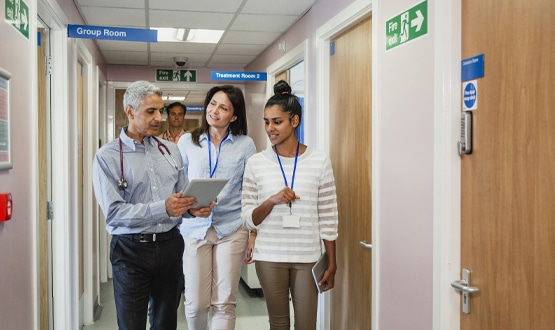Why NHS tech innovation can help to solve the backlog
- 10 February 2022

In a piece for Digital Health, Jacob West, director of health and life sciences at Microsoft UK, discusses why NHS tech innovation which was sparked by the pandemic has to continue in order to solve the backlog.
The number of people in England waiting to start routine hospital care hit six million for the first time in January – the highest since records began. With waiting lists rising by around 100,000 each month, attention must now turn to how this backlog of care can be tackled. In November, the Chancellor pledged a funding package of £6bn to tackle the issue. We know from the early 2000s that with sustained effort and funding, waiting times can be dramatically reduced. What’s different now, is the range of technology tools that we now have, to augment this effort. Ministers must now ensure that such technologies are rolled out in a structured way, to streamline processes, give staff back time and, ultimately, cut wait times.
Innovation in the age of Covid
Over the last two years, under conditions of expediency, the NHS took a great digital leap forward. In doing so, it has perhaps finally put to bed the lazy clichés about the pace at which it can innovate. The critical question now, is how this innovation can be sustained as we (hopefully) move away from the most serious phase of the pandemic, to address the dramatic backlog in care and provide a platform for further improvements in patient outcomes and experience, as well as helping to support a beleaguered workforce.
The pandemic witnessed an acceleration in the scale and scope of collaboration between technology and healthcare providers, with the NHS working to deploy tools such as Microsoft 365 to as many as 1.2 million staff, to enable staff to communicate and collaborate more effectively and to save costs. Patient perspectives have shifted too. Patients are now actively seeking remote consultations, which allow clinicians to see more patients per hour, with almost 80 per cent of people who used contact-free appointments reporting satisfaction with the service.
However, the pandemic has also laid bare the stark inequalities that still exist in healthcare outcomes, highlighting the pressing need to tackle the backlog of patients waiting for treatment, as well as modernising outdated systems. Although technology is not a panacea, it can augment clinical practice, give time back to care and help to ease backlog pressures.
More time to care
The challenge for the NHS now, is to put in place the infrastructure and tools needed to allow integrated care systems to flourish, by looking at where time savings can be made, particularly when it comes to back-office processes. Augmenting the healthcare professionals’ toolkit with technology that gives them more time to focus on delivering care, by streamlining administration, simplifying data-entry demands and automating certain tasks whilst retaining control. Enabling more effective consultations are just some of the ways that technology can play a role with reducing the backlog.
Technologies such as data and analytics, AI, IoT and the cloud can improve patient outcomes and support the reduction of waiting lists, by delivering more personalised treatments, enabling connected care from anywhere and providing clinicians with the data to facilitate preventative care. The rollout of ambient clinical technology could also aid doctors and other care givers in reducing the administration of clinical documentation and ultimately reduce burnout. By taking the heavy lifting from clinicians and automating processes wherever possible, they’ll have more time to focus on a greater number of patients in the same amount of time.
What does the future hold for the NHS?
As the NHS faces a challenging future, it should embrace the role that technology can play in supporting patients, caregivers, and systems. The goal should be to keep as many people as possible away from hospital, so the most in need of care can access it, while also continuing care remotely for those who need it. In many ways, this is the long-term change in care that all health systems need to put in place, as they deal with the trends of an aging population and chronic disease.
At every stage of the patient pathway there is opportunity for improvement – from digital triage in primary care and digital pre-operative assessments to new models of in-hospital patient flow and remote monitoring in the home. These changes can only be delivered by putting in place a modern data infrastructure and collaboration tools.
With the promised £2.1 billion investment from the Chancellor earmarked for the “innovative use of digital technology” on the horizon, a clear strategy is required to ensure that the investment will be used to drive better outcomes and increased productivity.
By working collaboratively with the technology industry, the NHS can be in control of its own future, shape its services and empower its staff to provide more personalised care and a better experience for patients, whilst also reducing waiting times. The NHS has an opportunity to build on the digital foundations accelerated by the pandemic, to create a truly integrated healthcare system, fit for the future and those who serve it.





3 Comments
A good example of this is using software to reprioritise patients for elective surgery. We are using a system called C2ai and am sure there must be others. It’s being very helpful in identifying patients that actually shouldn’t be having surgery because the risk from the surgery (usually the anaesthesia and hospital stay rather than the knife) is too high.
I don’t believe the NHS processes are working (where they exist) so automating them will achieve little. The concentration here should be revising and streamlining clinical processes then supporting them with appropriate (not just the latest and shiniest) tools and technology (they aren’t the same things). Remember:
Process begets design which is supported by tools etc, NOT the other way round.
This is true. if there are ways to shorten certain system steps to improve output in order to maximise patient satisfaction, i am sure that would be highly effective than just digitising everything. we should go back to the drawing board.
Comments are closed.